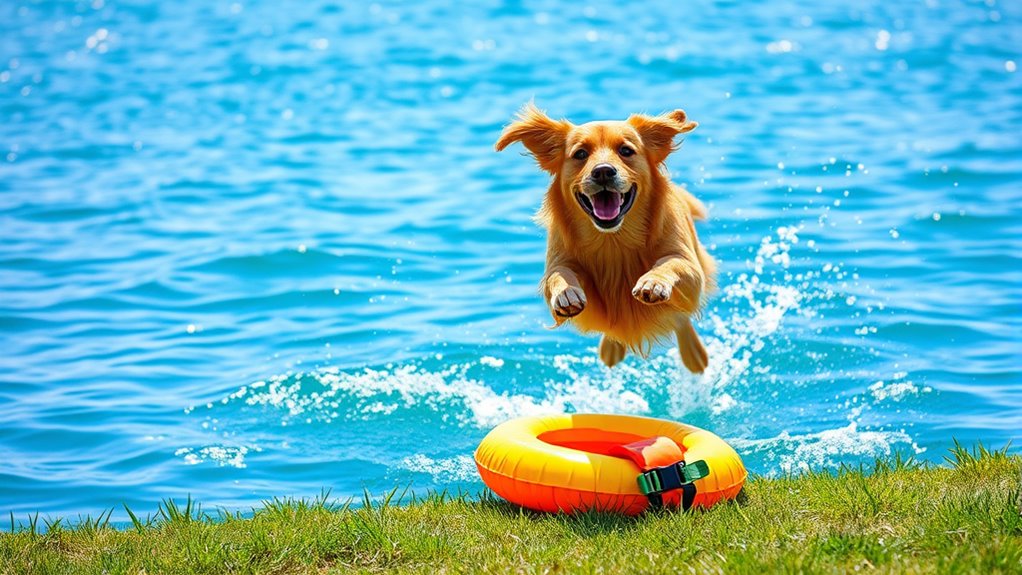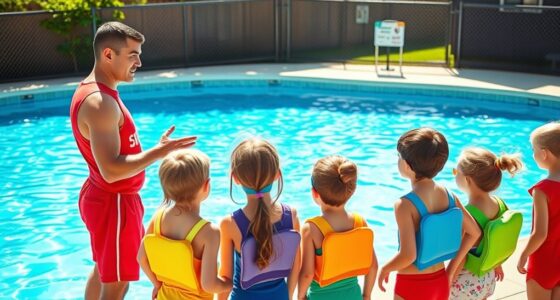To enjoy swimming with your dog safely, choose dog-friendly spots with shallow areas and minimal crowds, or consider private pools for more control. Introduce water gradually using positive reinforcement and keep sessions short. Make sure your dog wears well-fitted safety gear, and monitor for signs of fatigue or overheating like excessive panting, disorientation, or limpness. Rinse and dry your dog after swimming and watch their behavior to know when it’s time to exit. If you’re enthusiastic for tips to keep your pup safe and happy, there’s more to explore.
Key Takeaways
- Choose dog-friendly, clean swimming spots with shallow areas and minimal crowds for a safe experience.
- Use positive reinforcement and short sessions to help your dog build confidence in water.
- Always supervise closely, watch for signs of fatigue or overheating, and provide regular breaks.
- Equip your dog with a well-fitting flotation device and waterproof collar for safety and control.
- Rinse and dry your dog thoroughly after swimming to prevent skin issues and promote healthy fur.
Choosing the Right Swimming Spot for Your Dog
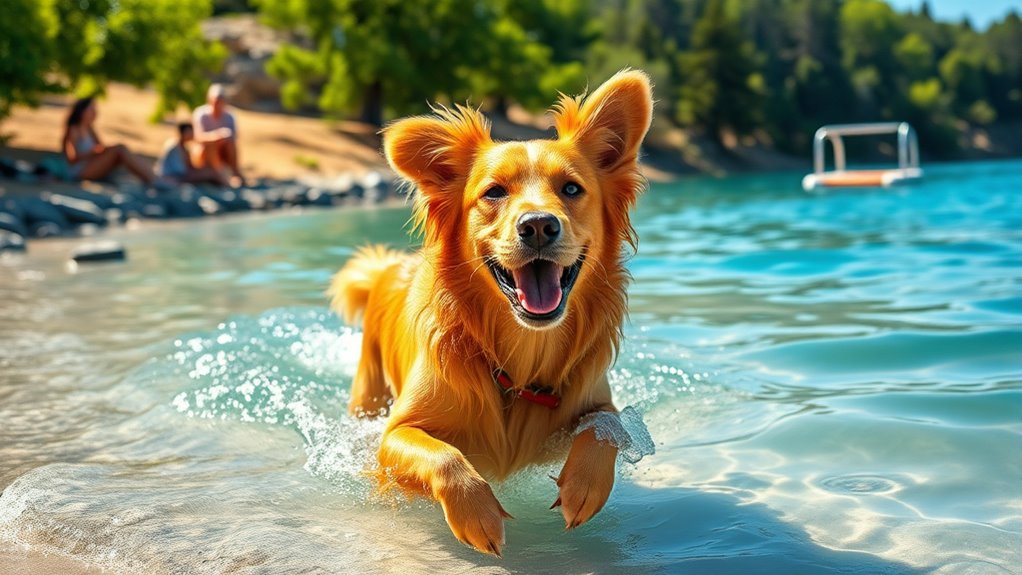
When selecting a swimming spot for your dog, safety should be your top priority. Look for dog-friendly beaches where the environment is welcoming and rules are clear. These beaches often have designated areas, shallow sections, and minimal crowds, reducing stress and safety risks. If you prefer privacy, consider setting up a private swimming pool in your backyard. This option gives you full control over the environment, water quality, and supervision. Ensure the pool has easy entry and exit points, and avoid pools with strong currents or dangerous equipment. Always check for local regulations and cleanliness, and avoid areas with sharp rocks, algae, or debris. Carefully monitoring your dog’s water quality and ensuring proper supervision can prevent health issues and make water activities safer and more enjoyable for your furry friend. Additionally, choosing a safe environment that minimizes hazards such as algae blooms or strong currents is essential for your dog’s safety. Being aware of water temperature is also important, as overly cold or hot water can affect your dog’s health and comfort. Regularly inspecting the swimming area for hazards can help prevent accidents and injuries. Moreover, understanding water safety practices can further protect your dog during water outings.
Introducing Your Dog to Water Gradually
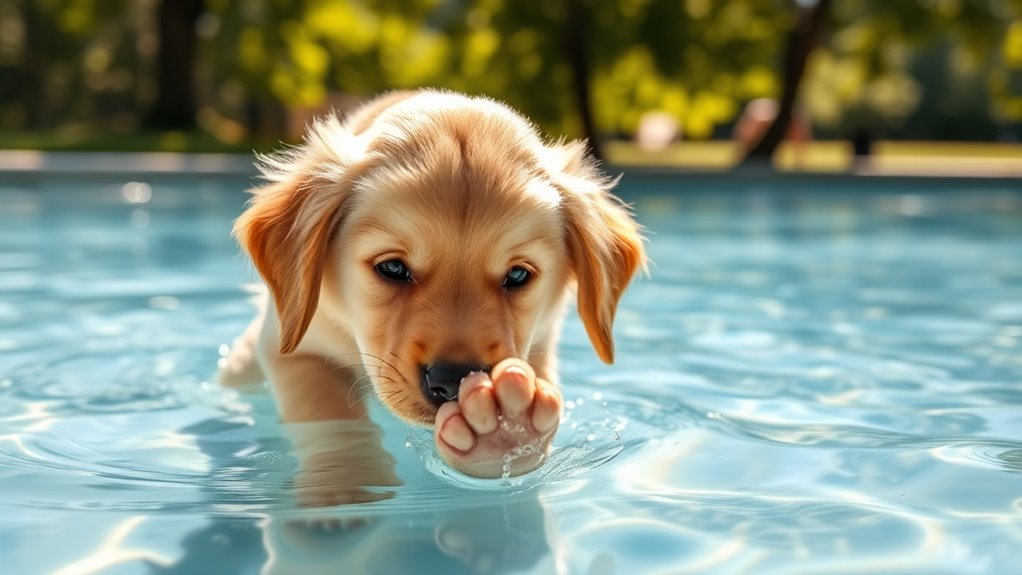
To guarantee your dog feels comfortable and safe in the water, it’s important to introduce them gradually. Start by letting your dog explore shallow water at their own pace, ensuring they remain calm and confident. Use positive reinforcement to build trust during each step, reinforcing good behavior with treats and praise. This approach is essential for dog water safety and effective canine aquatic training. Additionally, understanding water safety regulations can help ensure a safe environment during your outings. Keep sessions short and fun, and always monitor their reactions. Patience is key to helping your dog develop a positive association with water, making future swimming experiences enjoyable and safe for both of you. Incorporating proper grooming techniques can also help keep your dog comfortable during water activities and prevent skin issues. Recognizing the importance of automation in business can streamline your preparation and storage for water outings, ensuring everything is organized and accessible. Using aesthetic wall organization ideas can help create a safe and organized space for your water gear and cleaning supplies.
Ensuring Safety With Proper Equipment
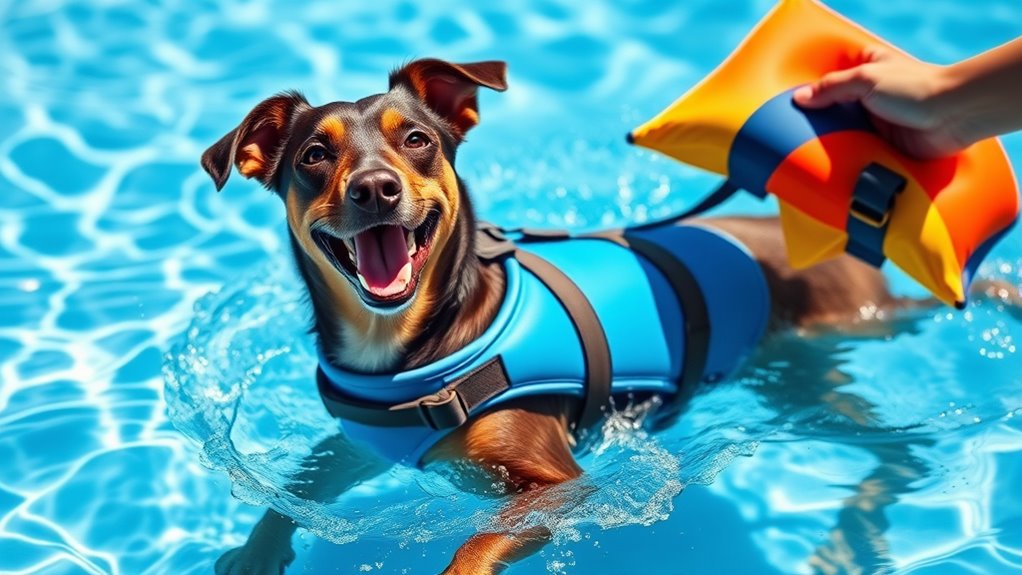
Using the right safety equipment is essential to keep your dog secure and confident during water activities. Dog flotation devices provide buoyancy, helping your dog stay afloat and reducing fatigue. Choose a well-fitted dog life vest with a secure handle for easy rescue if needed. Water safety gear, including waterproof collars and harnesses, prevent slipping and keep control within reach. Always make certain the equipment is appropriate for your dog’s size and swimming ability. Proper gear not only safeguards your dog but also enhances your peace of mind, allowing you to focus on fun and bonding. Regularly inspect all equipment for wear and tear before each swim. Being aware of symptoms of distress can help prevent accidents and keep your water experience safe. Additionally, understanding your dog’s water safety needs allows you to tailor safety measures effectively. With the right safety gear, you create a safer, more enjoyable water experience for your furry friend.
Recognizing Signs of Fatigue and Overheating
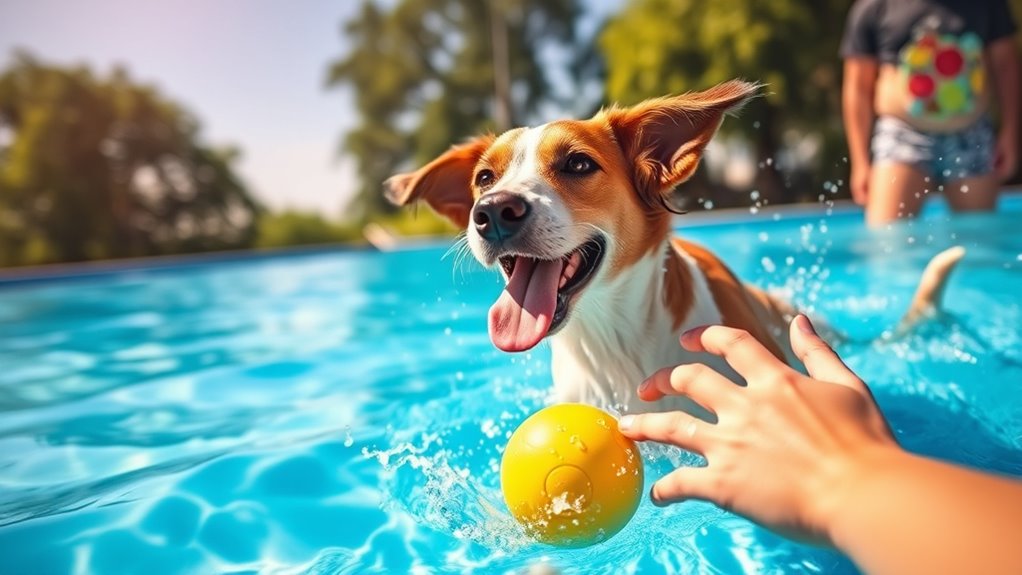
As your dog swims, keep an eye out for signs they’re getting tired or overheated. Notice if they’re panting excessively, showing weakness, or appearing disoriented. Recognizing these cues early can help you prevent serious health issues and keep your dog safe. Being aware of your dog’s vibrational energy can also assist in maintaining their well-being during water activities. Monitoring your dog’s body language can provide additional insights into their comfort level and stress signals. Additionally, paying attention to sensory processing cues can help detect early signs of discomfort or overstimulation. Understanding how your dog’s behavioral patterns change under stress can further aid in safeguarding their health during such activities. Recognizing the importance of water park safety tips can also prepare you for various scenarios to ensure a positive experience for your furry friend.
Watch for Excessive Panting
How can you tell if your dog is getting too tired or overheated during a swim? One key sign is their panting patterns. If your dog is panting excessively or irregularly, it’s a clear warning they’re struggling to cool down. Watch for rapid, shallow breaths or persistent heavy breathing, which can indicate heat exhaustion. If your dog’s panting doesn’t slow down or if they seem unable to catch their breath, it’s time to take a break and get them into shade and water to cool off. Overheating can escalate quickly, so staying alert to these signs helps prevent serious health issues. Additionally, monitoring your dog’s exfoliation and skin health can help detect early signs of heat stress, especially for dogs with sensitive or exposed skin. Proper air circulation around your dog during and after swimming can aid in preventing overheating. Ensuring good air quality in the environment where your dog swims and rests can make a significant difference in their ability to recover and stay comfortable. Being aware of your dog’s body language and overall behavior during swimming sessions can also provide valuable clues to their comfort level. Recognizing the importance of hydration is crucial, as dehydration can worsen heat-related problems. Always prioritize your dog’s comfort and safety, and don’t push them beyond their limits.
Look for Limpness or Weakness
When your dog starts to show signs of limpness or weakness, it’s a clear indication they may be tiring or overheating. Recognizing muscle weakness and limpness detection helps prevent serious issues. Watch for:
- Sudden floppiness in legs or head, indicating fatigue.
- Difficulty maintaining balance or coordination.
- Lethargy that persists despite rest breaks.
- Using eye patches as part of a skincare routine can help soothe and refresh tired eyes after a long day, much like providing a cool, shaded spot for your dog.
- Changes in color or viscosity of their saliva or skin can also be signs of overheating or dehydration, so keep an eye out for these symptoms.
- Regularly monitoring air quality indicators in the environment helps identify conditions that may contribute to overheating or respiratory issues in your dog.
- Ensuring proper insulation upgrades can help maintain a comfortable climate and prevent overheating during outdoor activities.
- Being aware of factors influencing body temperature regulation can further help you create a safe and comfortable swimming environment for your dog.
These signs suggest your dog’s muscles are losing strength and they’re becoming overwhelmed. Limpness can quickly turn into dangerous overheating if ignored. Keep a close eye on their movements and energy levels. If you notice these symptoms, it’s time to bring them out of the water and offer a cool, shaded spot. Promptly addressing muscle weakness and limpness detection ensures your dog stays safe and enjoys swimming without risking exhaustion or heat-related problems.
Monitor for Disorientation
Limpness and weakness are clear signs your dog is becoming overwhelmed, but disorientation can be subtler and just as dangerous. Watch for disorientation symptoms like confused behavior, stumbling, or difficulty focusing. Behavioral changes, such as sudden aimlessness or unresponsive reactions, often signal your dog is too tired or overheated. If you notice your dog drifting or seeming lost in the water, gently guide them to shore. Keep a close eye for signs of disorientation, as these often appear before more severe issues develop. Staying alert allows you to intervene early, preventing exhaustion or heatstroke. Remember, your quick response can make the difference between a fun swim and a dangerous situation. Always prioritize your dog’s safety by monitoring for behavioral changes throughout the swim.
Keeping Your Dog Hydrated During Water Play
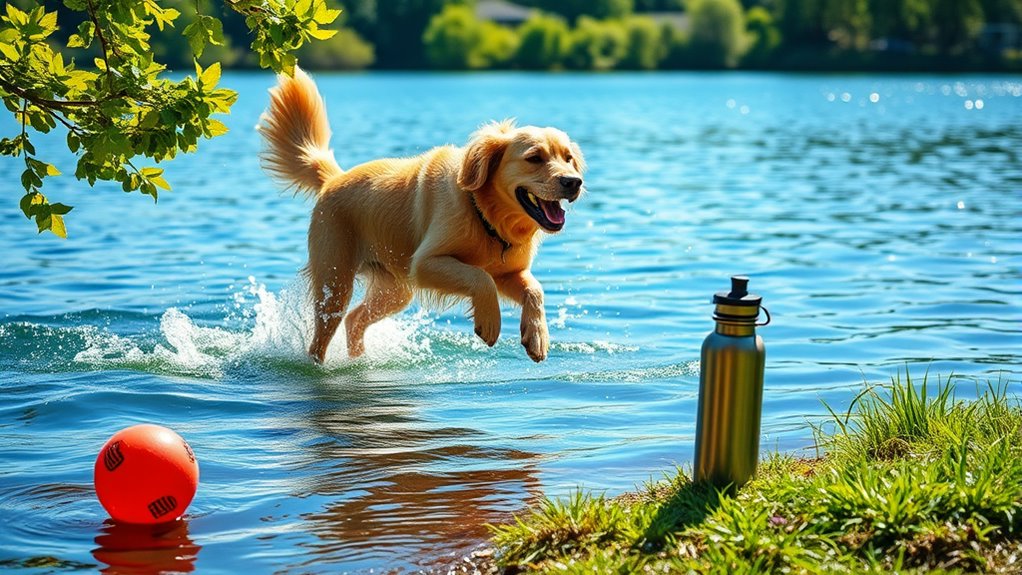
Staying well-hydrated is essential to guarantee your dog enjoys water play safely and comfortably. Make sure to provide easy access to hydration stations—like portable bowls or water bottles—so your dog can drink whenever needed. Keep an eye on their water intake, especially during hot days or vigorous activity, to prevent dehydration.
Picture your dog happily splashing around, pausing at a hydration station to sip water. Imagine a secure area with fresh water at their level, encouraging frequent drinking. Consider bringing a collapsible bowl or a water fountain for convenience, ensuring your furry friend stays refreshed and energized throughout their water adventure. Proper hydration helps maintain their stamina and overall well-being during water play.
Rinsing and Drying After Swimming
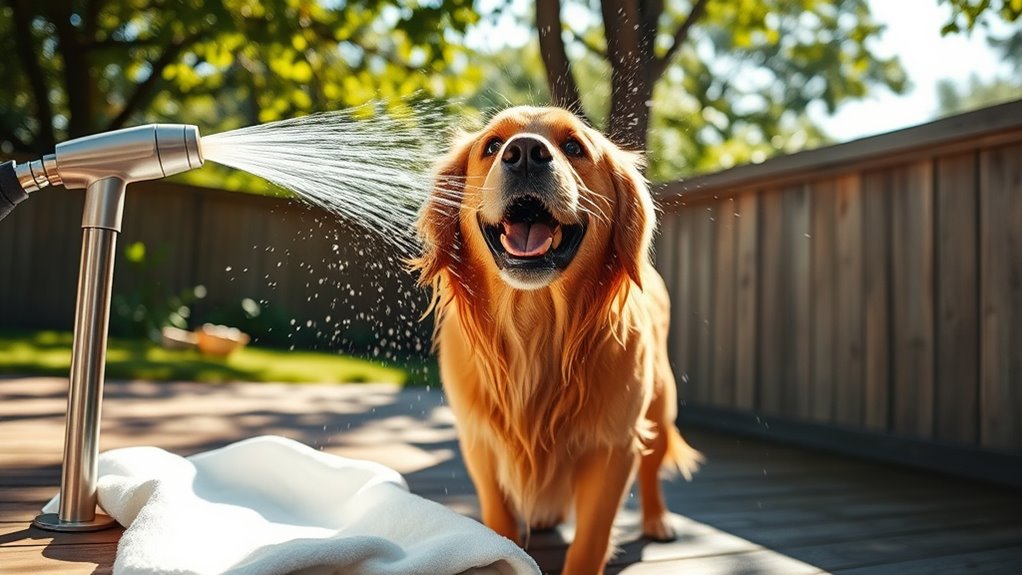
After swimming, you need to rinse your dog thoroughly to remove chlorine, salt, or mud that can irritate their skin. Using lukewarm water and gentle massage helps make certain all residues are gone. Once cleaned, dry your dog effectively with a towel or a low-heat blow dryer to prevent skin issues and matting.
Proper Rinsing Techniques
Proper rinsing is essential to remove chlorine, salt, or other contaminants from your dog’s coat after swimming. Use lukewarm water, not hot or cold, to keep your dog comfortable and prevent skin irritation. When rinsing, employ gentle, thorough techniques to make sure all residues are washed away.
- Gently massage water into the coat, avoiding the face and ears.
- Use a steady stream, moving from the neck down to the tail.
- Pay special attention to areas where contaminants can linger, like paws and underbelly.
Effective Drying Methods
To effectively dry your dog after swimming, start with thorough rinsing to remove residual chlorine, salt, or other contaminants. This step is essential for proper dog grooming and helps prevent skin irritation or infections. After rinsing, use a clean towel to gently pat your dog dry, paying special attention to ears, paws, and coat folds. If your dog has thick or long fur, consider using a pet-specific blow dryer on a low, cool setting—never hot—to speed up the drying process and guarantee water safety. Proper drying not only keeps your dog comfortable but also reduces the risk of hot spots or skin issues. Consistent drying routines promote healthy skin and fur, making your dog more comfortable and ready for their next adventure.
Monitoring Your Dog’s Behavior in the Water
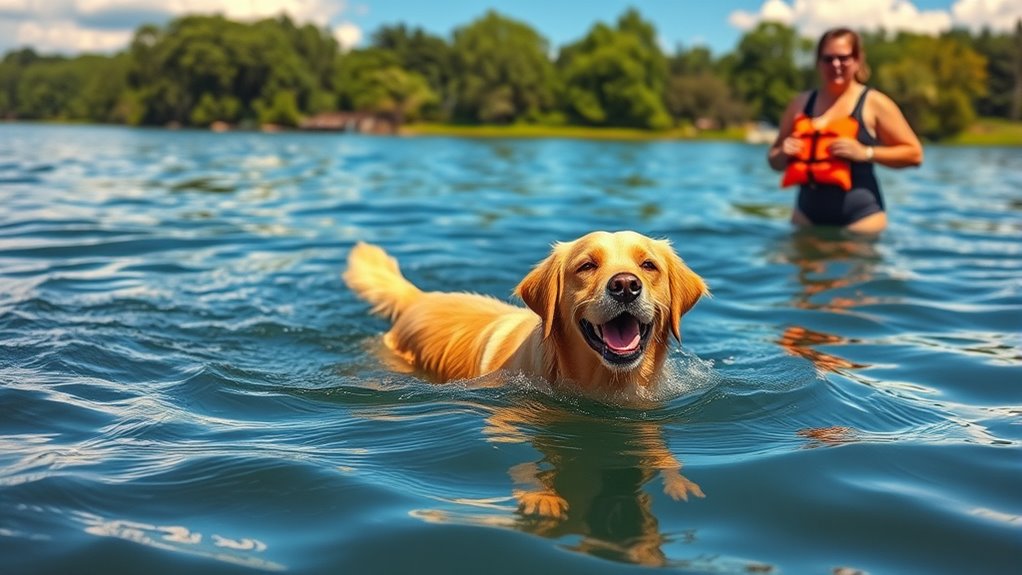
Keeping a close eye on your dog’s behavior while in the water is essential to guarantee their safety. Watching for canine behavior cues helps you identify signs of fatigue, discomfort, or distress early. When monitoring, look for:
- Excessive splashing or struggling, indicating tiredness or panic
- Lip licking, yawning, or avoiding eye contact, signaling stress
- Shallow or irregular breathing, showing fatigue or overheating
Knowing When to Exit the Water
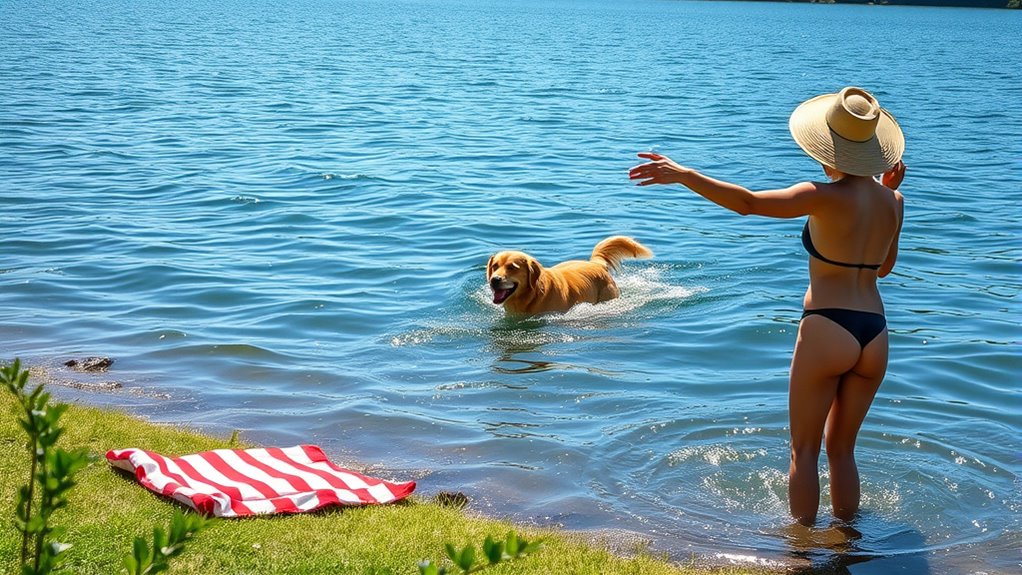
Knowing when to exit the water is essential for your dog’s safety and well-being. Watch for water exit cues like tiring movements, struggling to stay afloat, or excessive panting. If your dog shows signs of fatigue or stress, it’s time to guide them out calmly. Using safe exit strategies, such as leading your dog to the nearest shallow area or a designated ramp, helps prevent panic and accidents. Keep a close eye on their body language and avoid pushing them beyond their comfort zone. Remember, frequent breaks and gentle encouragement ensure they associate swimming with positive experiences. When your dog begins to tire or shows signs of discomfort, don’t hesitate—exit the water promptly for their safety. Proper timing can prevent exhaustion or distress.
Training Your Dog for Safe Swimming Skills
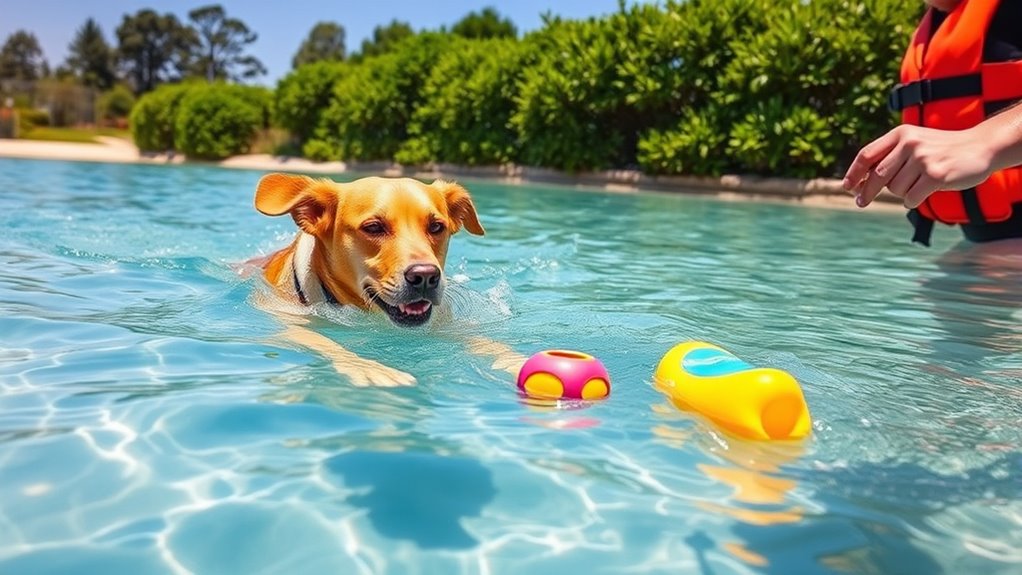
Training your dog for safe swimming starts with gradually introducing them to water in a positive and controlled way. You want to build their confidence while focusing on water safety. Start in shallow water, letting your dog explore at their own pace. Use treats and praise to create a positive association with swimming. Keep training sessions short and consistent, always monitoring their comfort level.
- Use a gentle leash or harness to guide your dog during initial water exposure
- Practice commands like “stay,” “come,”, and “leave it” to reinforce dog training for safety
- Gradually increase water depth as your dog becomes more confident and comfortable
Frequently Asked Questions
How Can I Tell if My Dog Enjoys Swimming?
To tell if your dog enjoys swimming, watch their body language and water confidence. If they enthusiastic approach the water, wagging tail and relaxed posture, they likely love it. Signs of discomfort include tense muscles, trying to get out, or resistance. Celebrate their enthusiasm, but always supervise closely. With patience and positive reinforcement, you’ll help your dog feel more confident and enjoy swimming even more.
Are There Breeds That Should Avoid Swimming?
Thinking about water-resistant breeds is like choosing the right gear for a hike; some are built for wet adventures, while others face breed-specific swim risks. Breeds like Bulldogs and Pugs have flat faces and short legs, making swimming difficult and risky. Avoid forcing these dogs into water, and always supervise their swimming to prevent accidents. Knowing your dog’s breed traits helps make certain safe, enjoyable water experiences.
What Are Common Water-Related Injuries in Dogs?
Water-related injuries in dogs can happen if you don’t prioritize water safety and injury prevention. Common issues include ear infections from water trapped in ears, cuts from sharp objects, or strains from jumping into deep water. To keep your dog safe, supervise closely, make certain they’re comfortable in water, and check for hazards. Proper precautions help prevent injuries, making swimming enjoyable and safe for your furry friend.
How Often Should I Take Breaks During Water Play?
Did you know that over 40% of water-related injuries in dogs happen because they overexert themselves? To prevent this, take regular breaks during water play, every 10-15 minutes. Keep an eye on your dog’s hydration needs, offering fresh water often. Also, monitor water temperature—avoid overly cold or hot water—so your furry friend stays safe, comfortable, and ready for more fun!
Can I Teach My Dog to Swim Independently?
You can teach your dog to swim independently with proper dog training and water safety measures. Start gradually, using positive reinforcement and a calm demeanor to build your dog’s confidence. Use a life jacket initially, and always supervise your dog around water. Consistent practice helps your dog become more comfortable, but never force them. Prioritize water safety to make certain a safe and enjoyable swimming experience for your furry friend.
Conclusion
Now that you know the basics, bring balance to your beach days by being vigilant, watchful, and alert. Keep your canine companion calm, confident, and cared for with constant caution and care. By choosing charming spots, checking cues, and championing safety, you can create carefree, fun-filled fetch sessions. Remember, your attentive approach ensures your dog’s delightful day in the water, turning simple splashes into memorable moments. Make every swim safe, satisfying, and sensational!

